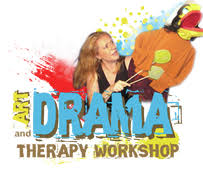Drama Therapy is a form of Creative Art Therapy. " *Providing opportunities for the participant to express feelings, emotions or thoughts that may not expressed through typical interactions. *Increasing interaction amongst group participants.
 *Generating reminiscence and reflection on life experiences. *Generating reminiscence and reflection on life experiences. *Increasing self understanding and acceptance. *Building a communal spirit."
'When thinking of Drama Therapy, many believe the only approach is to re-create formal plays, having participants memorize lines. Drama therapy offers many more opportunities for personal expression. In fact, focusing on pre-designed plays is not what Drama Therapy is all about. It is the goal of the facilitator to introduce experiences which will allow the elder resident/client to act out life roles - utilizing past life experiences, memories and even regrets.
 To introduce your clients to the concept of "play acting", try some of these warm up activities. It's important to promote reminiscense and discussion regarding the topics/actions demonstrated and reviewed. To introduce your clients to the concept of "play acting", try some of these warm up activities. It's important to promote reminiscense and discussion regarding the topics/actions demonstrated and reviewed.
 Action or Emotion Exercises : Have emotions (sadness, happiness, anger) or actions (make a cup of tea, change a baby, hanging clothes) written on index cards. The participants pick a card, act out the emotion or action and the remainder of the participants guess what it is. Action or Emotion Exercises : Have emotions (sadness, happiness, anger) or actions (make a cup of tea, change a baby, hanging clothes) written on index cards. The participants pick a card, act out the emotion or action and the remainder of the participants guess what it is.
Name Exchange : The leader begins by saying his/her name and something he/she likes. In addition to saying what it is they like, they create an action to pantomime the preference. Each participant introduces themselves with their name and what they like, with a corresponding action.
Magic Box : An empty box is brought to the group and various exercises can be practiced such as... -A favorite thing can be pulled out of the bag (pantomime) and shown" to the other participants.  -Things that you dislike or want to get rid of can be put into the bag/box. The participant has to pull the unwanted item (could be someone, something or an emotion) out of the air or nearby space and push it into the bag/box.-Individuals can be pulled out of the box or bag. People they want to introduce to the group or they can act like the person, demonstrating their characteristics and traits.
Once comfortable with the idea/process, try some more intense activities which involve extended interactions and "drama". -Things that you dislike or want to get rid of can be put into the bag/box. The participant has to pull the unwanted item (could be someone, something or an emotion) out of the air or nearby space and push it into the bag/box.-Individuals can be pulled out of the box or bag. People they want to introduce to the group or they can act like the person, demonstrating their characteristics and traits.
Once comfortable with the idea/process, try some more intense activities which involve extended interactions and "drama".
Where shall we go? : Using narrative, pantomime, dialogue and improvisation - arrange participants into a "vehicle" and head to a mutually agreed upon destination. As the trip progresses, participants act upon what they see and wish to do along the way.

Dilemma Dramas : Present real life situations - "what would you do if..." and have the participants act out their reactions, actions or responses to the event.
Continuous Story : An imaginary story is introduced. For example, "we are sitting in a field - having a picnic lunch and suddenly..."
The action begins with the participants filling in the story. Props, visual aides, sound effects and music foster greater participation and ideas.
Paper Bag Skits : A mixed, variety of unrelated items (or they can be related) are placed into the bag. The items can be pulled out, one by one, and a story is created with the items as a stimulus.'

Check out these Drama Therapy sites.
  
 tips tips
|




No comments:
Post a Comment